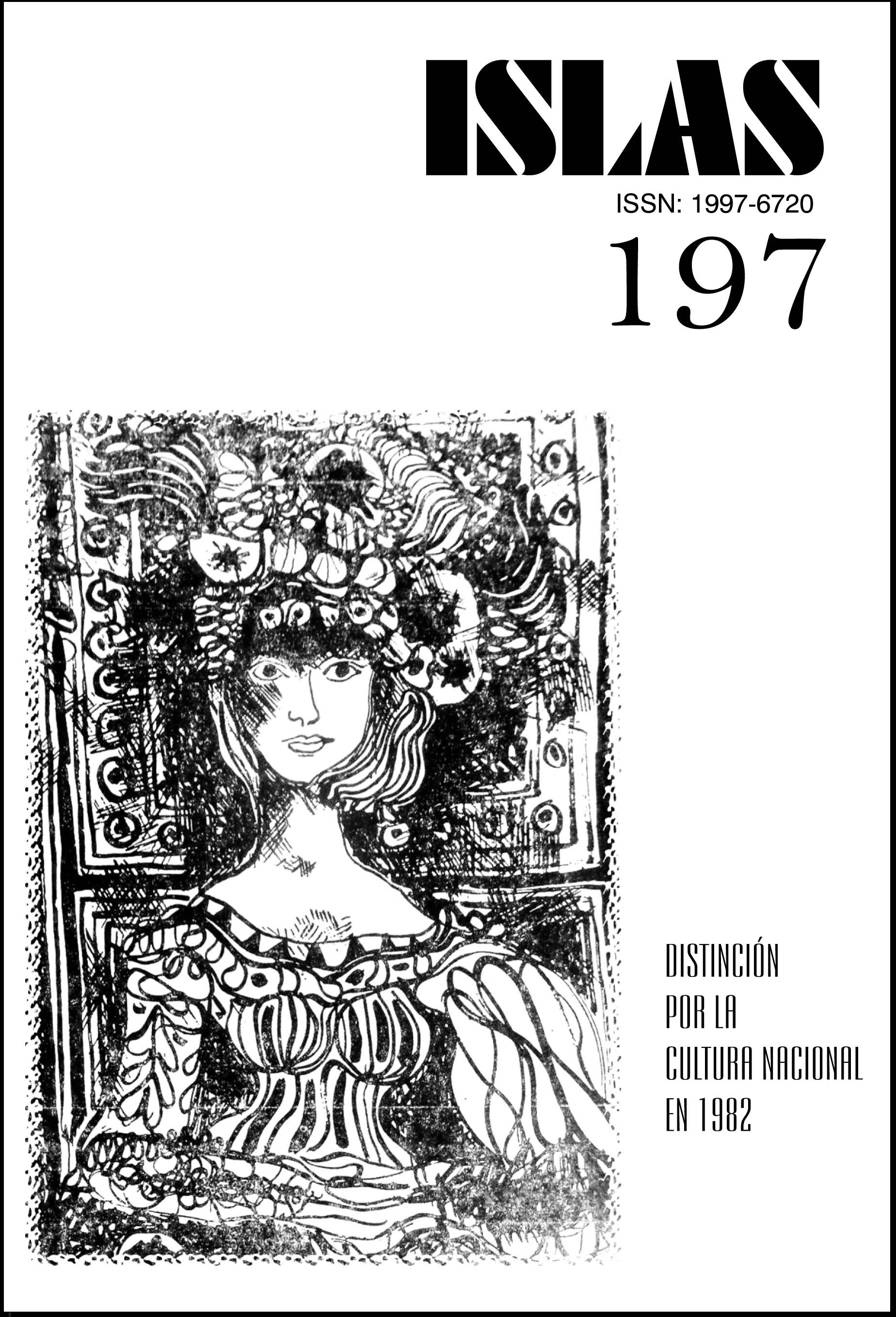Impacto de los fenómenos climáticos en la historia de Matanzas, Cuba (1690-1876) / Impact of climatic anomalies and phenomena in the history of Matanzas city, Cuba (1690-1876)
Palabras clave:
climatic events in history, Little Ice Age, Matanzas city, fenómenos climáticos en la historia, Pequeña Época de Hielo, ciudad de MatanzasResumen
Este texto provee un registro de las condiciones y fenómenos
climáticos más significativos acaecidos en la región Habana-Matanzas
entre 1692 y 1876. Este registro fue extraído detalladamente de documentación
primaria, historiográfica y meteorológica procedente de literatura
científica moderna para establecer una relación entre los efectos climáticos
y la geografía humana en el entorno de la bahía de Matanzas. Nuestro
análisis apoya que los fenómenos y anomalías climáticas jugaron un rol
significativo en el desarrollo arquitectónico, urbanístico y socioeconómico
de Matanzas desde su fundación en 1693, pero considerablemente durante
la segunda mitad del siglo xviii y comienzos del xix. La integración de la climatología
al análisis histórico nos permite acceder, aunque limitadamente,
a detalles meteorológicos no registrados en los documentos, que a la vez
admiten reconstruir condiciones locales que marcaron nuestra historia.
This article provides a record of noteworthy climatic events
occurred on the Habana-Matanzas region between 1692 and 1876. This
record was extracted from detailed primary and historiographical documentation,
plus meteorological data from modern climatic scientific
literature, in search of a relationship between the adverse effects of
events such as hurricanes, ENSO events, local storms, drought and
floods on human conditions, in the area around the Matanzas Bay. We
corroborate that climate played a significant role in the urbanistic and
socioeconomic development of Matanzas since its foundation in 1693,
but more considerably during the second half of the 18th and early 19th
century. The integration of climatology to historical research provides,
although limitedly, inferences on meteorological conditions that are not
available from document evidence, and thus allowing for generalized
reconstruction of conditions which marked local history.
Descargas
Citas
Abrantes, F., Rodríguez T., Rufino M., Salgueiro E, et al. (2017). The climate of the Common Era off the Iberian Peninsula. Climate of the Past, 13, 1901–1918.
Alfonso, P. A. (1854). Memorias de un Matancero: Apuntes para la Historia de la Isla de Cuba con Relación a la Ciudad de San Carlos y San Severino de Matanzas. Matanzas : Imprenta Marsal.
Baron, W. R. (1992). Chapter 4: Historical climate records from the northeastern United States, 1640 to 1900. En Bradley, R. S. & Jones, P. D. (edit.) Climate Since A. D. 1500. Routledge, London, 74-91
Black, D. E., Thunell, R. C., Kaplan, A., y Peterson, L. C. (2004). A 2000-year record of Caribbean and tropical North Atlantic hydrographic variability. Paleoceanography, 9, PA2022.
Baumgartner, T., Michaelsen, J., Thompson, L., Shen, G., y Casey, R. (1989). The recording of interannual climate change by high-resolution natural systems: tree-rings, coral bands, glacial ice layers and marine varves. Aspects of climate variability in the Pacific and Western Americas. Geophysical Monograph. American Geophysical Union, 55, 1-14.
Briffa , K. R., Jones, P. D., Schweingruber, F. H. y Osborn, T. J. (1998). Influence of volcanic eruptions on Norther hemisphere summer temperature over the past 600 years. Nature, 393, 450-455.
Bradley, R., y Jones, P. (1992, editores) Climate Since A.D. 1500. London: Routledge.
Büntgen, U. et al. (2017). New tree-ring evidence from the Pyrenees reveals western Mediterranean climate variability since Medieval times. Journal of Climate, 30, 5295-5318.
Callejas Leal, G., y O’Donnell, H. (1999). 1762. La Habana inglesa. La toma de La Habana por los ingleses. Madrid: Agencia Española de Cooperación Internacional.
Casas y Vázquez, A. de (1930). Datos Históricos de Matanzas. Matanzas: Imprenta Estrada.
Cangialosi, J. P., Latto, A. S. & Berg, R. (2018). National Hurricane Center tropical cyclone report: Hurricane Irma. NOAA/NWSRep. AL112017: https://www.nhc.noaa.govdata/tcr/AL112017_Irma.pdf.
Caviedes, C. (2001). El Niño In History: Storming Through the Ages. Gainesville: University of Florida.
Cook, E., Seager, R., Cane, M., Stahle, D. (2007). North American drought: reconstruction, causes, and consequences. Earth Science Review, 81(1-2), 93-134.
Cooper, J. y Peros, M. (2010). The archaeology of climate change in the Caribbean. Journal of Archaeological Science, 37(6), 1226-1232.
Cotarelo, R. (1993). Matanzas en su Arquitectura. La Habana: Letras Cubanas.
Curtis, J.H., Brenner, M. and Hodell, D.A. (2001). Climate change in the Circum-Caribbean (Late Pleistocene to Present) and implication for regional biogeography. In Woods, C.A. & Segile, F. (eds.), Biogeography of the West Indies (Second Edition). CRC Press, Boca Raton, Florida, 35-54.
D’Arrigo, R., Cook, E. R., Wilson, R. J., Allan, R. y Mann, M. E. (2005). On the variability of ENSO over the past six centuries: Geophysical Research Letters, 32, L03711.
Escalona, M. S. y S. T. Hernández (2008). El Urbanismo Temprano en la Matanzas Intrarrios (1693-1840). Ediciones Matanzas, Matanzas.
Evans, M. N., Kap lan, A., y Cane, M. A. (2000). Intercomparison of coral oxygen isotope data and historical sea surface temperature (SST): potential for coral-based SST field reconstructions. Paleoceanography, 22, PA3210.
Fernández, M., (1871a). Estudio sobre los huracanes ocurridos en la Isla de Cuba durante el mes de octubre de 1870. Imprenta de J. M. Lapuente, Madrid.
Fernández, M. (1871b). Sobre las bajas y ondas barométricas observadas en los huracanes de la Isla de Cuba. Sesión del 23 de abril de 1871. Anales de la Academia de Ciencias Médicas, Físicas y Naturales de La Habana, VIII (8), 57-61.
Folland, C. K., Karl, T. R. y Vinnikov, K. Ya. (1990). Observed climate variations and change. En J. T. Houghton, G. J., Jenkins y J. J. Ephraums (editors). Climate Change. The IPCC Scientific Assessment. Cambridge University Press, Cambridge, 194-238.
Friis-Christensen, E., and K. Lassen (1991). Length of the solar cycle: An indicator of solar activity closely associated with climate. Science, 254, 698-700.
Gagan, M., Ayliffe, L., Beck, J., Cole, J., Druffel, E., Dunbar, R., y Schrag, D. (2000). New views of tropical paleoclimates from corals. Quaternary Science Review, 19, 45-65.
García, A. (2009). Matanzas: La Atenas de Cuba. Polymita, La Habana.
García, A. (2017). Matanzas: Primera Urbe Moderna de Cuba. Matanzas: Ediciones Matanzas.
Garza, G. G. (2014). Caracterización de la Pequeña Edad de Hielo en el México central a través de fuentes documentales. Boletín del Instituto de Geografía de la UNAM, 85, 82-94.
Gergis, J. L. y Fowler, A. M. (2009). A history of ENSO events since A. D. 1525: implications for future climate change. Climate Change, 92(3-4), 343-387.
Graf ensteine, J. von (2002). La Habana, Veracruz y Puebla en el negocio de harinas y viveres, 1750-1810: el tema, su historiografía y fuentes para su estudio. América Latina en la historia Económica, 9(17-18), 127-142.
Gregory, B.R.B., Peros, M., Reinhardt E.G., and Donnelly, J.P. (2015). Middle-late Holocene Caribbean aridity inferred from foraminifera and elemental data in sediment cores from two Cuban lagoons. Palaeogeography, Palaeoclimatology and Palaeoecology, 426, 229–241.
Hernández, O., Orihuela, J., Rodríguez, B. (2019). Capítulo 2: Fortificando la bahía de Matanzas: el torreón de El Morrillo. En Hernández , O. y Orihuela, J. (editores) Fortificaciones de Matanzas: 1693-1876. Buenos Aires: Ediciones Aspha, 61-73.
Hereid, K. A., Quinn, T. M., y Okumura, Y. M. (2013a). Assessing spatial variability in El Niño-Southern Oscillation event detection skill using coral geochemistry. Paleoceanography, 28(1): https://doi.org/10.1029/2012PA002352.
Hereid, K. A., Quinn, T. M., Taylor, F. W., Shen, C. C., Edwards, L., & Cheng, H. (2013b). Coral record of reduced El Niño activity in the early 15th to middle 17th centuries. Geology, 41(1), 51-54. https://doi.org/10.1130/G33510.1
Herrera, D. (1847). Memoria sobre los huracanes en la Isla de Cuba. La Habana: Imprenta Barreira.
Johnson, S. (2011). Climate and Catastrophe in Cuba and the Atlantic World in the Age of Revolution. Chapel Hill: University of North Carolina Press.
Johnson, S. (2015). The history and science of hurricanes in the Greater Caribbean. En Oxford Research Encyclopedia, Latin American History. Oxford: Oxford University Press, 1-23.
Jones, P., y Bradley, R. (1992). Climate variations over the last 500 years. En Bradley, R., y Jones, P. (editores) Climate Since A.D. 1500. London: Routledge, 649-665.
Jones, P., y Mann, M. (2004). Climate over past millennia. Review of Geophysics, 42, 1-42.
López, I. (2019). Ingeniería e Ingenieros en Matanzas: Defensa y Obras Publicas entre 1693 y 1868. España: Athenaica.
Malaizé, B., Bertran, P., Carbonel, P., Bonnissent, D., Charlier, K., Galop, D., Iambert, D., Serrand, N., Stouvenot, C. y Pujol, C. (2011). Hurricanes and climate change in the Caribbean during the past 3700 years BP. HAL, 21(6), 911-924.
Marrero, L. (1976). Cuba: Economía y Sociedad Vol. 4. Madrid: Editorial Playor, S. A.
Marrero, L. (1978a). Cuba: Economía y Sociedad Vol. 6 (primera parte). Madrid: Editorial Playor, S. A.
Marrero, L. (1978b). Cuba: Economía y Sociedad Vol. 6 (segunda parte). Madrid: Editorial Playor, S. A.
Marrero, L. (1984). Cuba: Economía y Sociedad Vol. 11. Madrid: Editorial Playor, S. A.
Martínez, U. (1999). Historia de Matanzas, Siglos xvi-xviii. Matanzas: Ediciones Matanzas.
Martínez, J. M. (1857). Crónicas de la iglesia parroquial de San Carlos de Matanzas exhortadas de los archivos de la misma [sic] (inédito). Biblioteca del Conservador de la Ciudad de Matanzas, Cuba.
Melero, M. de J. (1870). Los Huracanes de la isla de Cuba: Bajas y ondas barométricas observadas (leída en nombre de Fernández de Castro). Anales de la Academia de Ciencias Médicas, Físicas y Naturales de La Habana, VII, 329.
Millás, J. C. (1923). Huracanes que han afectado a Cuba desde 1494 a 1856. Boletín del Observatorio Nacional de Cuba, 19:87-93.
Millás, J. C. (1968). Hurricanes of the Caribbean and Adjacent Regions. Academy of the Arts and Sciences of the Americas.
Moberg A., Sonechkin, D.M., Holmgren, K., Datsenko, N.M., Karlen W. (2005). Highly variable Northern hemisphere temperatures reconstructed from low- and high-resolution proxy data. Nature, 433, 613–617.
Moy, C. M., Seltzer, G. O., Rodbell, D. T., y Anderson, D. M. (2002). Variability of El Niño/Southern Oscillation activity at millennial timescales during the Holocene epoch. Nature, 420,162-165.
Newhall, C. G. y Self, S. (1982). The volcanic explosivity index (VEI): An estimate of explosive magnitude for historical volcanism. Journal of Geophysical Research, 87, 231-1238.
Orihuela, J. y Hernández, O. (2018). La Academia de Ciencias de Cuba y las investigaciones arqueológicas en el sitio El Morrillo: apuntes historiográficos. Cuba Arqueológica, 11(1), 19-35.
Orihuela, J., Hernández, O. & Viera, R. A. (2018). Órdenes reales y prácticas locales: el Castillo de San Severino de Matanzas y la dinámica colonial (1683-1698). Islas 60(191), 39-68.
Orihuela, J., Viera, R. A. & Pérez, L. (2019). Demografía fundacional de San Carlos de Matanzas, Cuba del siglo XVIII. Islas (61)193, 68-93.
Pérez, J., Ballester, M. Olivera, J. y Rodríguez, E. (2013). Caracterización de las trayectorias de los ciclones tropicales en la cuenca Atlántica en relación con la actividad solar y otras variables. XI Congreso Cubano de Informática y Geociencias (2013), 1-18.
Pérez, L. (1992). Historia del Catolicismo en Matanzas. Matanzas: Editorial Augusto de Coto.
Pérez, L. (1989). Vigencia de las ideas del padre Viñes en el estudio de la meteorología actual. Trabajo investigativo, Instituto Superior Pedagógico, Matanzas.
Pérez L. y Santana, C. (1985-2017). Bitácora Ciclónica de Matanzas. Observaciones directas de ciclones pasados por la ciudad. Inédito.
Pérez, R., Vega, R. y Limia, M. (2001): The Tropical Cyclones in Cuba: A Current Revision of the Historical Information. Boletín de la Sociedad Meteorológica de Cuba, 7(2).
Peros, M., Gregory, B. Matos, F., Reinhardt, E. y Desloges J. (2015). Late-Holocene record of lagoon evolution, climate change, and hurricane activity from southeastern Cuba. The Holocene, 25(9), 1483–1497.
Pezuela, J. de la (1868). Historia de la Isla de Cuba. Tomo segundo. Madrid: Carlos Bailly-Bailliere.
Poey, A. (1862). Table Chronologique de Quatre Cents Cyclones (Depuis 1493 Jusqu’en 1855). París: P. Dupont.
Ponte, F. J. (1959). Matanzas: Biografía de una Provincia. La Habana: Imprenta El Siglo xx.
Quintero, J. M. (1878). Apuntes para la Historia de la Isla de Cuba con relación a la Ciudad de Matanzas. Matanzas: Imprenta El Ferrocarril.
Rodríguez-Ferrer, M. (1876). Naturaleza y Civilización de la Grandiosa Isla de Cuba. Parte Primera. Madrid: Imprenta de J. Noguera.
Roig, E. (1929). La Dominación Inglesa en La Habana: Libros de Cabildos 1762-1763. La Habana: Imprenta Molina y Cia.
Rojo-Garibaldi, B., Salas de Leon, D. A., Sanchez, N. L., Monreal-Gomez, M. A. (2016). Hurricanes in the Gulf of Mexico and the Caribbean Sea and their relationship with sunspots. Journal of Atmospheric and Solar-Terrestial Physics, 148: DOI: 10.1016/j.jastp. 2016.08.007.
Sarasola, S. (1928). Los Huracanes en las Antillas. Madrid: Bruno del Almo.
Schwartz, S. B. (2015). Sea of Storms: A History of Hurricanes in the Greater Caribbean from Columbus to Katrina. Princeton: Princeton University Press.
Steinhilber, F., Beer, J., & Frohlich, C. (2009). Total solar irradiance during the Holocene. Geophysical Research Letters, 36: L19704.
Tannehill, I. R. (1945). Hurricanes, 6th Edition. Princeton: Princeton University Press.
Treserra, J A. (1941). Reseña Histórica de Matanzas 1508-1941. Gobierno Provincial de Matanzas. La Habana: Imprenta La Revoltosa.
Valcárcel, R. (2002). Inundaciones y sociedad aborigen en el territorio de los municipios Mayarí y Sagua de Tánamo. Departamento Centro, Orientas de Arqueología, Holguín, 1-17.
Vecchi, G. A. y Soden, B. J. (2007). Global warming and the weakening of the tropical circulation. Journal of Climate, 20:4316-4340.
Vento, E. (2002). La última morada. Matanzas: Ediciones Matanzas.
Viera, R. A. & Pérez, L. (2012). Arqueología histórica en contextos fundacionales de la Ciudad de Matanzas, Cuba. Cuba Arqueológica V (1), 41-44.
Viera, R. A., Niebla, I., Pérez, L. & Orihuela, J. (2017). Nuevos datos arqueológicos procedentes del sitio de la iglesia fundacional de Matanzas, Cuba. Cuba Arqueológica 10(2), 79-83.
Viera, R. A., J. Orihuela León, L. Pérez Orozco e I. Niebla (en prensa). Primera iglesia de San Carlos de Matanzas: Acercamiento arqueológico e histórico. Cuba Arqueológica.
Viñes, B. (1870). Huracanes del 7 y 10 de octubre de 1870. La Habana: Imprenta y Librería Religiosa.
Viñes, B. (1878). Apuntes relativos a los Huracanes de las Antillas en septiembre y octubre de 1875 y 76 (discurso). La Habana: El Iris.
Descargas
Publicado
Cómo citar
Número
Sección
Licencia
Derechos de autor 2020 https://creativecommons.org/licenses/by-nc/4.0/

Esta obra está bajo una licencia internacional Creative Commons Atribución-NoComercial 4.0.
Usted es libre de:
Compartir — copiar y redistribuir el material en cualquier medio o formato
Adaptar — remezclar, transformar y construir a partir del material
La licenciante no puede revocar estas libertades en tanto usted siga los términos de la licencia
Bajo los siguientes términos:
Usted es libre de:
Atribución — Usted debe dar crédito de manera adecuada, brindar un enlace a la licencia, e indicar si se han realizado cambios. Puede hacerlo en cualquier forma razonable, pero no de forma tal que sugiera que usted o su uso tienen el apoyo de la licenciante.
NoComercial — Usted no puede hacer uso del material con propósitos comerciales.
No hay restricciones adicionales — No puede aplicar términos legales ni medidas tecnológicas que restrinjan legalmente a otras a hacer cualquier uso permitido por la licencia.












